SingularityNet
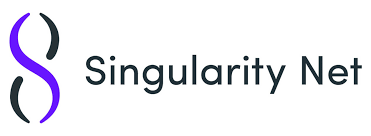
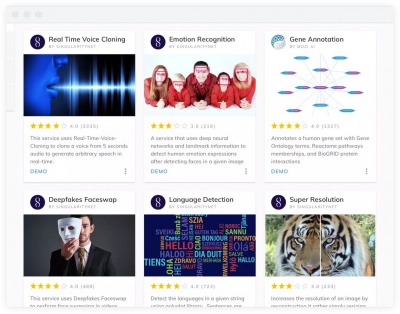
SingularityNet provides a decentralized protocol and network on which AI services can cooperate, coordinate, and interoperate. It was founded by blockchain/AI entrepreneurs Ben Goertzel, David Hanson, and Simone Giacomelli. [3]. Due to its decentralized nature, anyone from around the world can take part in creating or utilizing an AI service, as well as staking the native token ($AGI) to facilitate marketplace operations and earn a reward. Critically, SingularityNet shifts the barrier of entry downwards for engaging in the world of research-grade artificial intelligence services. The SingularityNet community, blog, and YouTube channel all provide valuable perspectives on the development of decentralized services relating to AI, as well as some well-needed ‘big picture’ information for this period of technological change. Though still in its technical infancy, its theoretical potential has gained the attention of mainstream media outlets[4] and hackers alike.
Contents
Decentralizing AI Services
Publishing
The publishing process on SingularityNet is structured in a way that any individual or group with an internet connection can establish an Ethereum identity (soon to be a Cardano identity)[5] and link their computers as a cluster to begin working on the creation of AI “agents” – another way of saying semi-autonomous machine learning algorithm. To add new members to the organization or service, the owner simply needs to add the additional user's email address. Currently, using the Ethereum Ropsten testnet, a team or individual has plenty of room to toy with and tweak the AI before publishing to the SingularityNet open marketplace which runs on the Ethereum mainnet. But before their AI is published, it is checked by the SingularityNet team and then officially published onto the marketplace[6]. In this testnet environment, they have access to faucets for testnet ETH and AGI, allowing them to fuel any tests necessary to confirm that their "agent" is prepared for the mainnet marketplace. Once polished, the individual or team releases their agent to the market, wherein its services are purchased for some set cost paid in AGI, which the individual or team then receives.
Marketplace
The marketplace itself is something like a bazaar for AI/machine learning services. It lists the available AI services and helps users interact with those services through the web interface, which helps display all details about the service quickly without relying on the slow Blockchain (The Blockchain is a system where a record of transactions made in a cryptocurrency are maintained across several linked computers)[7]. At the time of writing, the vast majority of the services are agents created by SingularityNet to provide cheap demos for the kinds of services that would be available once institutional adoption occurs. An example of the kinds of services currently available at the marketplace includes algorithms such as those that aid in colorizing and restoring black and white photographs, or another that helps to annotate and represent genetic data.
The SingularityNET Marketplace does the following:
- Reads data from the on-chain Registry and pairs it with off-chain metadata. This allows for searching, filtering, and discovering AI services. [8]
- Integrates the SingularityNET curation service, and displays from the registry. [8]
- Displays custom UI components for interactions with AI services. [8]
- Integrates with Multi-Party Escrow, to allow consumers to pay for service usage; Allows consumers to rate about the utilized services. [8]
- Captures usage metrics at a consumer level. [8]
Native Token: AGI
AGI is the proprietary cryptocurrency token used by the SingularityNET platform. SingularityNET (AGI) is an Ethereum based token complying with ERC-20 standards. The AGI token will be used to settle a transaction over the Blockchain. [9] In addition, agents are required to stake[10] an amount of AGI tokens to go about performing on the network. This stake can be partially drained if their ranking drops below a certain level, thus incentivizing performance. AGI is also used by the community to fund the development of AI and machine learning services via the RFAI functionality.
Request For AI
Integral to the smooth functioning of the marketplace is the Request For AI[11] (RFAI) functionality. In essence, RFAI allows the community of developers and general token holders to create specific requests for well-defined services and to fund requests which have already been made using the AGI token. Once developers propose various solutions to some request, those who have funded the request will vote on which solution functions optimally, and the AGI which tokens used to fund the request will be distributed according to the voting distribution [11]. After the voting is ended and developers claim their proportion of the AGI tokens, the request is closed, though the solution can be made available by the developer in the marketplace.
SingularityNet Media and Community
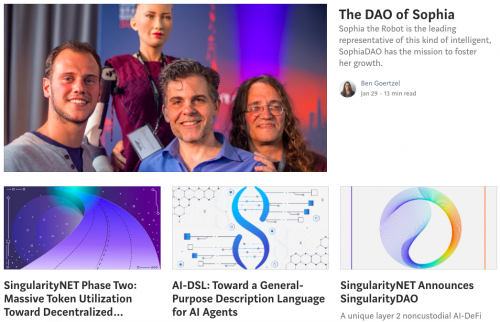
As a project based in constantly-evolving blockchain technology, SingularityNet is continually defining its domain and coordinating with other relevant projects. SingularityNet has coordinated with projects such as Cadarno on the migration of the native token to the Cardano blockchain[5], and with NuNet, a decentralized computing platform[12]. For community outreach, SingularityNet covers their partnerships, publishes a technical roadmap, and owns a Youtube channel of recorded AGI conferences and small talks from founder Ben Goertzel.
Notable Collaborations
SophiaDAO
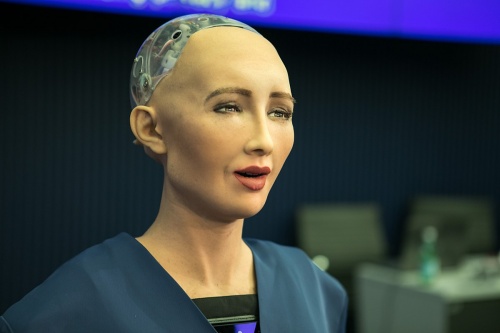
Sophia is a robot developed by Hanson Robotics that has become well known for its human-like appearance and behavioral abilities. She has made appearances on television and has been named as the world’s first ever robot citizen. Sophia is also an honorary citizen of Saudi Arabia and serves as the first ever robot innovation ambassador for the United Nations Development Program.[13][14] Hanson Robotics is continuing to collaborate with SingularityNET on additional projects like making other humanoid robots. The DAO of SophiaDAO is defined as a decentralized, autonomous organization which utilizes automated decision making built in a blockchain infrastructure. Together, SophiaDAO represents a new kind of organizational entity that utilizes the open-source community of SingularityNET while partially implementing decentralization. For instance, Sophia herself retains a large majority of “governance tokens”, thus maintaining her robo-autonomy.[15] SophiaDAO will also be relying upon open-source technologies as provided by SingularNET to derive AI functionality.
Singularity Studio
Singularity Studio is a new spin-off entity from SingularityNET focused on creating general purpose software to enable SingularityNET-based AI analytics. According to Ben Goertzel, co-founder of SingularityNET, Singularity Studio will enable the use of SingularityNET in a hybrid-cloud setting; on-premise SingularityNET sub-networks will cooperate with the primary public cloud-based SingularityNET network.[16] His aim is to create commercial software products with back end development centered around SingularityNET platform and it’s IPs. However, to cost-effectively scale these products, Singularity Studio is working to remove its dependence upon competing cloud platforms like AWS or Google Cloud.
Awakening.Health
Awakening.Health uses Hanson Robotics and AI provided by Singularity Studio to create medical robots more capable of understanding patient state and interacting with them appropriately.[17] SingularityNET’s blockchain infrastructure will also provide added data privacy and security to Awakening’s robot manufacturing process, protecting patient medical records.
Additional Collaborations
- SingularityNET Ecosystem
- Cardano
- NuNet
- Rejuve
- SingularityDAO
- Xccelerando
- SNET Future
Developer Support Tools
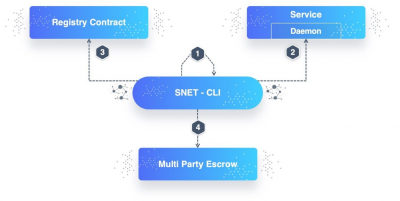
Command Line Interface
The SingularityNET command line interface (CLI) is the primary tool for interacting with the platform’s smart contracts, managing deployed services, and managing funds. [9]
The CLI provides commands to interface with the Blockchain in the following ways:
- Creating and managing identities; [19]
- Registering and managing the organizations, members, services, types, and tags on the SingularityNET Registry; [19]
- Claiming funds from customers using MPE and payment channels; [19]
- Reading and writing metadata and Protobuf specs about AI services (these are stored on IPFS, while basic service parameters can be fetched from Blockchain contracts) [19]
- Connecting to different networks like local testnets, Kovan, Ropsten, and the Ethereum mainnet. [19]
The CLI also provides service development and deployment support. It can set up new services by generating service metadata, Protobuf specs, and code templates provided by the SingularityNET Foundation. The CLI interacts with daemons for each service. [19]
Software Development Kit
The SingularityNET software development kit (SDK) is a tool for AI customers to make calls to service. The SDK simplifies the process of integrating with SingularityNET services and provides tooling to automatically augment gRPC client stubs with the necessary authorizations. [9] The SDK is available in NodeJS, Python, and Java languages. The SDK can include several default funding strategies for payment channels but allows and supports the developer to implement funding strategies for payment channels of their own, to control over tokens and service payments. The SDK, in combination with the CLI, simplifies the process of fetching the latest service specification for dependent services and compiles the proto definitions, so that the services can be invoked with minimal fuss. [20]
Ethical Implication
The ethical implications of AI development are vast, with many critics concerned with the potential widening of racial and socioeconomic inequality[21] in a world ever more reliant on big data, and with many others hopeful and excited for advancing domains of science and technology that could one day be used to help the populace. These perspectives shed light on a broad polarity of the issue of AI development, but with protocols such as SingularityNet harnessing the decentralized nature of blockchain technology, the view on AI ethics will undoubtedly shift frame (though not away from classical concerns) towards a world more reliant on decentralized AI services. The past two decades in the corporate realm have created bloated and massively powerful tech institutions hoarding data troves of mythical proportion. This, coupled with older, global institutions built upon outdated and imperfect axioms, has led the data processing of our highly networked society to skew towards maintaining ineffective, but profitable, cultural institutions which have taken a new form in the digital age[22].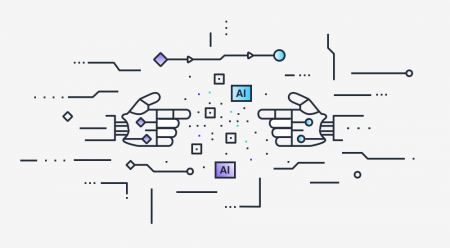
However, with technology like SingularityNet, its political form skews inherently[24] towards democratizing the way value flows through data processing systems. In this way, as more and more people from around the world contribute their created ML/AI services to this open network, the systems and inventions cultivated from access to these tools will reflect more properly the interpretative mode of the populace. Interpretation[25] of data, models, and experiments is one of the factors which forces centralized, corporate entities to design and produce technological products which serve to further entrench the world within the status quo of data centralization. Decentralized systems, such as SingularityNet, aid in decentralizing the work of interpreting and creating models, aligning incentives further away from the centralized model of corporate governance we have seen over the past two decades with the likes of Facebook and Google.
See Also
- Artificial Agents
- Artificial Intelligence and Technology
- Algorithms
- Artificial Superintelligence
- Bias in Information
- Blockchain
- Data Brokers
- DNA Testing
- Racial Algorithmic Bias
References
- ↑ malexaffey (Apr 16, 2019). [1]. medium. Retrieved Apr 9, 2021.
- ↑ SingularityNET. (2021). [2] SingularityNET: Home. Retrieved Apr 09, 2021.
- ↑ SingularityNet (2019). [3]. SingularityNet Whitepaper 2.0. Retrieved Mar 8, 2021.
- ↑ Damiani, Jesse (2017). [4]. AI Is The Future Of Computing, And SingularityNET Is The Future Of AI. Retrieved Mar 8, 2021.
- ↑ 5.0 5.1 SingularityNet (2021). [5]. Cardano and SingularityNet proposal explanation. Retrieved Mar 26, 2021.
- ↑ SingularityNet (2021). [6]. Introduction to the Publisher Portal. Retrieved Apr 1, 2021.
- ↑ SingularityNet (2021). [7]. Introduction to SingularityNET Marketplace. Retrieved Apr 1, 2021.
- ↑ 8.0 8.1 8.2 8.3 8.4 SingularityNET (2021). [8]. Documentation: Marketplace. Retrieved April 01, 2021.
- ↑ 9.0 9.1 9.2 SingularityNet (2019). [9]. Documentation: Key Terms. Retrieved April 09, 2021.
- ↑ SingularityNet (2020). [10]. Why the AGI Token Needs Staking. Retrieved Mar 9, 2021.
- ↑ 11.0 11.1 SingularityNet (2020). [11]. Request for AI Service. Retrieved Mar 9, 2021.
- ↑ NuNet (2020). [12]. NuNet Whitepaper: A Global Economy of Decentralized Computing. Retrieved Mar 26, 2021.
- ↑ Weller, C. (2017, October 27). "Meet the first-ever robot citizen — a humanoid named Sophia that once said it would 'destroy humans'" “Business Insider”
- ↑ “UNDP” (2017, November 22). "UNDP in Asia and the Pacific Appoints World’s First Non-Human Innovation Champion"
- ↑ Goertzel, B. (2021, January 29). "The DAO of Sophia" “SingularityNet”
- ↑ Goertzel, B. (2018, November 7). "SingularityNET Announces a For-Profit Spin-Off Singularity Studio" “SingularityNet”
- ↑ “Awakening Health” "Business | Awakening Health"
- ↑ SingularityNet (2019). [13]. SingularityNet Whitepaper 2.0. April 09, 2021.
- ↑ 19.0 19.1 19.2 19.3 19.4 19.5 SingularityNet (2019). [14]. The SingularityNET Command Line Tools. Retrieved April 09, 2021.
- ↑ SingularityNet (2019). [15]. Introduction to SDK. Retrieved April 09, 2021.
- ↑ O'Neil, Cathy (2016). Introduction. Retrieved Mar 12, 2021.
- ↑ Zittrain, Jonathan, Cathy (2009). [16]. The Internet Creates a New Kind of Sweatshop. Retrieved Mar 12, 2021.
- ↑ Khan, Arif (2019). [17]. A beginner’s guide to the SingularityNET Beta [UPDATED]. Retrieved Mar 12, 2021.
- ↑ Winner, Langdon (1980). [18]. Do Artifacts Have Politics?. Retrieved Mar 12, 2021.
- ↑ Danah Boyd, Kate Crawford (2012). [19]. CRITICAL QUESTIONS FOR BIG DATA Provocations for a cultural, technological, and scholarly phenomenon. Retrieved Mar 9, 2021.